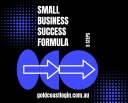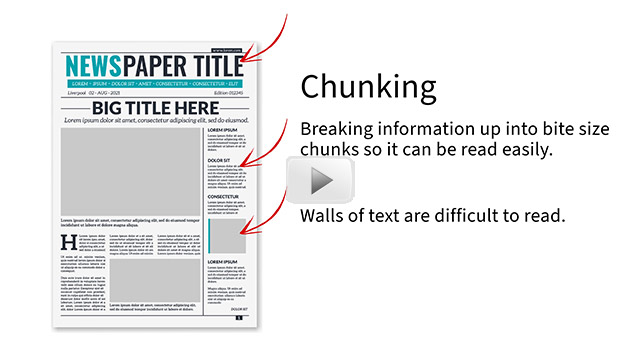Writing for SEO

- Jan 8, 2020 modified: Jul, 25 2025
Writing for SEO
Original article 8 Jan 2020 - Updated Jul 2025
How to Format Blog Posts for Improved Readability and SEO
I was lucky enough to be walking down the hallway at University after graduating in 1999, a lecturer of User Interface Design stepped out of his office and mentioned Vince who was lined up to do User Interface Design tutes in 2000 couldn't do it because his Flash web software was taking off and he was heading to the US for the dotcom boom. Would I be interested he asked? 13 years of User Interface Design lecturing followed that conversation - I even got to share an office with Vince and yes you would like to hear his stories of the absolute boom in Silicon Valley.
"User Interface (UI) Design focuses on anticipating what users might need to do and ensuring that the interface has elements that are easy to access, understand, and use to facilitate those actions"
This article is about using UI principles to enhance formatting readibility and importantly SEO of your BLOG or articles like this.
We have found Google to be very responsive to well written content. The use of artificial intelligence to determine the quality of writing has been a bonus for SEO companies who favour writing quality.
Google is also extremely tolerant of poor websites. However thinking in terms of the payload Google must endure to crawl sites, (see crawl stats below) it may be less tolerant of bloated, poorly constructed sites that are heavy on the download. Hence we see Problems with Wordpress.

Googlebot primarily crawls websites from US IPs
Since Googlebot primarily crawls websites from US IPs, it may pay to consider hosting based in the US if that suits your website traffic. Latency is the amount of time it takes for data to be sent from one point to another. Having a site hosted OS can slow down your site.
"Google's crawlers and fetchers are designed to be run simultaneously by thousands of machines to improve performance and scale as the web grows. To optimize bandwidth usage, these clients are distributed across many datacenters across the world so they're located near the sites that they might access. Therefore, your logs may show visits from several IP addresses. Google egresses primarily from IP addresses in the United States."
Analysing Server Logs to check pages crawled
Google search console provides information on pages indexed. Further analysis can be obtained from your server logs. Analysis of these logs indicates which pages on your site are getting the most attention from the Google bot (Googlebot/2.1;). This information shows that Google does not have a set standard pattern for indexing pages. As an SEO we are interested in which pages are getting the attention.
Key here is to ensure your site is fast and responsive. Most sites out there do not pass W3C validation tests without errors. However Google still ranks sites riddled with errors, with scripts loading that aren't even used, with images way to big in size and all sorts of issues. The standards are important rules for company's producing browsers. It is surprising how many sites fail to comply with the web standards.
"The information retained in server log files typically include client IP address, request date and time, the page URL requested, the HTTP response code, the volume of bytes served as well as the user agent and the referrer."
A typical log from Googlebot
66.249.68.71 - - [12/Mar/2024:08:41:32 -0700] "GET /enhanced-email-marketing-tool-for-your-website HTTP/1.1" 200 18680 "-" "Mozilla/5.0 (Linux; Android 6.0.1; Nexus 5X Build/MMB29P) AppleWebKit/537.36 (KHTML, like Gecko) Chrome/122.0.6261.94 Mobile Safari/537.36 (compatible; Googlebot/2.1; +http://www.google.com/bot.html)"
The point of writing for SEO can be-:
- Boost the site the article is on
- Boost other sites via links
- Attract potential clients to the site
- A combination of the above
A typical "keyword stuffed SEO blog" can make for poor reading. So it may look like an authentic article but read very poorly. The pages where every paragraph is virtually a repeat with the same keyword laden phrases and childlike writing. Google is not at all fond of "duplicate content" - content that is virtually word for word from other sites. Keep your blog posts original and unique.
Add some "English as a second language" poor writing skills and you can see why Google is favouring well written, grammatically correct writing and penalising cheap outsourced SEO techniques.

How does formatting influence your article?
The article needs to be easy to read. A block of solid text, page wide is no fun for readers, even if the content is good. Google can detect this, and acts on it. There are up to 1400 dots per inch (DPI) in printed brochures and booklets whilst 72 dots per inch on some screens. It is simply harder to read a screen than printed material. This is a core UI principle, designing for the screen needs an alternative approach to that annual report brochure.
There needs to be high quality formatting to enhance the written word.
This is achieved by a working knowledge of Cascading Style Sheets (CSS). These are a set of instructions that allow easy spacing and formatting of code. Systems like Twitter Bootstrap allow one core set of instructions as a base, allowing you to only learn a few specific enhancements based on the template or theme you use.

Cascading Style Sheets (CSS) is a simple mechanism for adding style (e.g., fonts, colors, spacing) to Web documents. The term 'Cascading' refers to the instructions cascading down, so you can set design rules that do not need to be written for every line of text. A paragraph will look a certain way and a paragraph with a certain 'class' added will have slightly alternative looks.
By mixing styles up appropriately you make your text easier to read.
Didn't bother learning HTML, CSS and scripting? Don't expect to be able to work as effectively as an SEO unless you take the time to perfect these skills. If you outsource, there is another person required to create your article.
The meaning of the article needs to be easily scanned and understood.

Whitespace needs to be used, chunking or grouping of content is important.

We like to keep our Google listing to one line to enhance readibilty.
The User Interface Design principle PARC-:
Proximity - associating a design element with another eg text near an image or a caption
Alignment - how an element is aligned for example consistently aligning left
Repitition - following consistent design rules
Contrast - use of contrasting elements to stand out
Selling - Marketing
Selling, marketing, calls to action, creating a sense of urgency or scarcity. Usually you are working on the emotions to create an action.
So again a "keyword stuffed SEO blog" could work against this aim of appealing to the emotions of the visitor. We use a leading sales coach to learn ethical sales techniques.
Many sales techniques are designed for face to face communication. The more experienced or longer a business owner has been running a business the less decisions are made on Emotion the more on Logic. In the written word you do not know the experience of your reader. These are the challenges we need to overcome. What impression is your article creating for the user? Some articles will be designed for action or to achieve a specific purpose, others may be way to general - they may present an opportunity for a person visiting your site, but not actually acheive an immediate sale.
User Interface Design schools discuss the use of Personas to identify the different users for an interface. Your writing must be designed for a user or level of user in mind.
We avoid the "hard sell" at all costs. Create different ways for the visitor to contact you. For example a person working in an office may prefer to make use of a contact form. People who do not want to be sold to, must be catered for. People may find you 'not through the front door' so navigation and menu systems must align to user expectations.
Making those contact forms usable and validated with a personal message at the end is really important. Just because the person has made contact does not mean they have stopped exploring your site, and good custom contact form can end with an offer or your latest YouTube video.
How do you measure if an article is effective?
As an SEO, metrics are your friend. Any system or tool that measures success or otherwise of your article is important.
We use SEO Tools to help discover-:
- Ranking pages on the site
- Ranking keywords on the site
- How many other pages are visited (on average) from this page
- Keyword opportunities
- Your Competitors
- Social Media Influencers
Statistics are only important in context. For some clients, all that matters is if the phone rings or contact forms are completed. Some clients will get too many eqnquiries, however that is desired compared to the alternative.
Some examples of effective articles
My secret weapon is to use pHD qualified researcher Dr Steve Gration as an SEO Writer. As a Gold Coast based SEO many people would be familiar with Steve in his work as president of Save Our Spit. Fortunately for the Gold Coast, Steve's ability to think, write, and discuss has helped save chunks of beach and green space in this beautiful location.
You may notice with Steve's articles they are definitely not your typical "keyword stuffed SEO article" and do break some SEO must do conventions. They most definitely work for effective SEO. There is never one and only one way to achieve good SEO rankings.
Here are some of Steve's articles-:
- HAPPINESS - Why Should We Believe Hilda?
- What Communication Style Do You Use?
- Is Your Home Killing You or just making you sick?
- AIR POLLUTION - Beyond the Haze
- The Dukes of Hazard
- Printing Stickers and Other Pressing Matters
- Yoga and Karate
Technologies/Skills to help produce a good article
- Advanced Native (English) Writing Skills
- HTML
- CSS
- Images
- Typography
- Statistics eg Google Analytics / Google Console
- SEO Profiling software (quickly analyse the effectiveness of SEO)

Checklist for better BLOG formatting
- Create a cheatsheet of formatting examples-:
- Include a good CSS
blockquoteformat for quotes - Include a good divider
- Include slideshows
- Include list elements to enhance lists (like this)
- Include CSS
margin-topfor headings to give that beautiful whitespace - Include image floats to easily place images left or right
- Include a list of font-icons available
Search News Articles...
Recent Articles

Most AI Websites Fail to Rank
- Nov 18 2025
- /
- 193

Sitemap.xml Best Practices
- Oct 14 2025
- /
- 472

Fake Reviews on Google My Business
- Oct 07 2025
- /
- 409

Sending Emails from Code
- Sep 17 2025
- /
- 511

US Tariff Shifts Undermining eCommerce
- Sep 05 2025
- /
- 631

Small Business Success Formula
- Aug 23 2025
- /
- 498

Do Strong CTAs Help or Hurt Your Website?
- Jul 31 2025
- /
- 696

AI Crawlers vs Search Crawlers
- Jul 04 2025
- /
- 827

AI vs. Human Writing - How to detect Ai
- Jun 26 2025
- /
- 1230

Optimising for Brand SEO
- May 12 2025
- /
- 899
View All News Articles
Categories
A Gold Coast SEO and Web Developer
